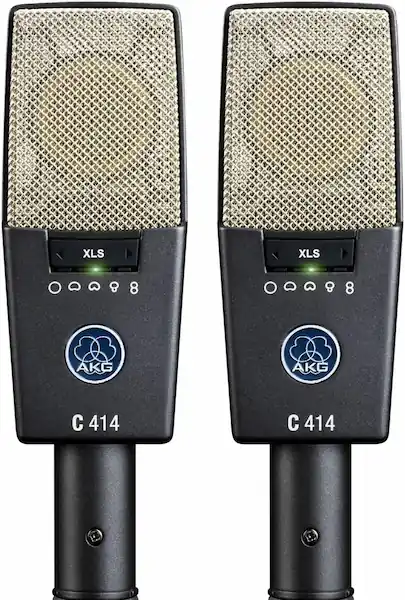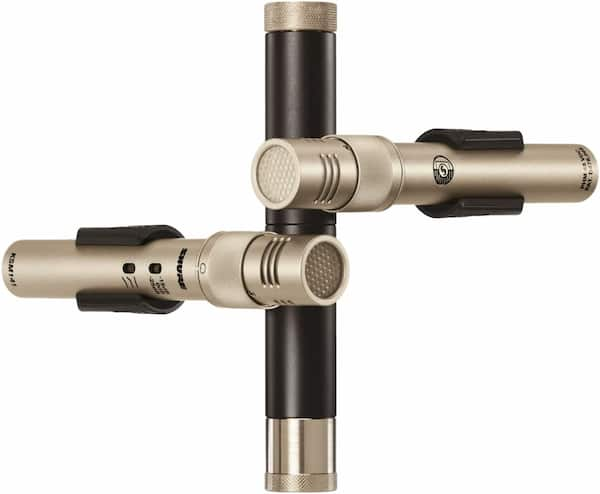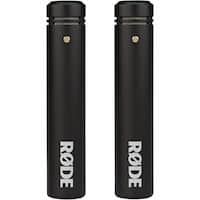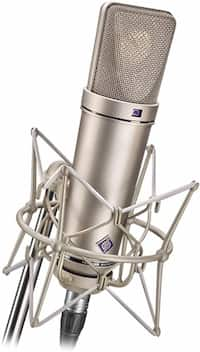Best Microphones for Recording Piano

There is a reason why the piano is one of the most beautiful-sounding instruments in the world. With an array of complex harmonics, overtones, and nuances, everything from the world to the strings to the room will have a significant impact on its tone.
Capturing all of the nuances to get that natural tone means using the right microphones in the optimal position.
To help you capture that sound with ease, we've compiled a list of the top ten best microphones for recording piano.
Note: some of the links below may be affiliate links, meaning that I receive a commission if you purchase through them.
10 Best Mics for Recording Piano
Here are the ten best microphones for recording piano. For best results, make sure your sound source (i.e. the piano), is in tune and well maintained. Nothing will ruin a take more than a creaky foot pedal or an out of tune set of strings.
 |
Neumann U87 | Luxurious, amazing piano (and vocals), but VERY expensive |  |
 |
Warm Audio WA-84 | Like a Neumann, for a fraction of the price |  |
 |
Rode NT 5 | Perfect balance of quality and affordability for most home studios |  |
 |
AKG C 414 XLS | A super high quality large diaphragm condenser mic; fairly expensive |  |
 |
Rode M5 | An affordable pair of transparent small-diaphragm condenser mics |  |
 |
Shure SM7B | Great for supplementing condenser mics or for live performances |  |
 |
Audio Technica AT2020 | A respectable budget-friendly mic. It's not going to wow you, but it gets the job done for under $100 |  |
 |
Beyerdynamic MC 930 | Clean, warm piano tone, with some serious durability |  |
 |
Shure KSM141 | Reasonable all-around small condenser mic for those those on a budget |  |
 |
Behringer C2 | Ultra-budget stereo condenser mics - average sound but incredible price! |  |
Once you've got your perfect microphones, don't forget to check out this article on how to mic a piano!
💰 Rode M5 - Best Budget Stereo Condenser for Mic'ing Piano 💰
Rating: 8.5
Best for: Super-affordable pair of transparent small-diaphragm condenser mics
Get yourself a pair of Rode M5s, and you'll have access to some of the most popular and versatile condenser microphones for acoustic instruments in the industry. The beauty of these entry-level microphones is that they deliver a crisp and lively sound without burning a hole in your pocket.
Compared to a cheap set of matched pair condenser mics, you'll notice significantly less harshness in the high frequencies. Instead, you get a warm and natural sound that emphasizes the best nuances of the acoustic piano.I love how small this matched pair is. With a length of just 10cm and a width of 2cm, it is one of the shortest and most compact microphones on this list, making it very easy to set up in any configuration.
You won't find any pad switches or roll-off switches on these microphones, so proper placement is crucial.When it comes to placement, note that you can take advantage of the 140dB SPL design, allowing you to close mic without fear of distortion. You also get a 20Hz-20kHz range, more than enough to capture the entire frequency spectrum of the piano. You'll likely notice a slight bump in the 7kHz range, which offers a nice bit of presence.
🏆 Neumann U 87 - Perfection Comes with a Price 🏆
Rating: 9.5
Best for: Luxurious, amazing piano (and vocals), but VERY expensive
The Neumann U87 has long been one of the best microphones for recording pianos.Neumann is one of the oldest microphone manufacturers in the industry, and the U87 is somewhat of a staple. Like many of these mics, you get to switch between three different polar patterns for added flexibility, allowing you to capture multiple directions with the large, dual-diaphragm capsule.
Beyond that, you will find a pad and a low-cut switch on this microphone, perfect for use in a variety of recording situations.As you can expect from such a large condenser microphone, you get a full-range frequency capture from 20Hz to 20kHz. However, to me, it almost feels as if that range is an undersell. With the added sensitivity, you can almost hear the air flying off the strings each time the hammers clamp down. And if there is too much low-end, you can always turn on the switchable high-pass filters.
What truly makes this microphone sound great is the slight dips in the boundary frequencies, curbing any excess brightness or boom that might occur in dynamic recordings.The result is a well-defined mid-range and a round bass response, capturing every nuance you might need to use in your track. If there were any downsides to this microphone, it would be the size. With such a large body compared to some of these matched pair mics on the list, setting the microphone up in tight recording situations can be tricky.
Warm Audio WA-84 - The Neumann Alternative
Rating: 8.5
Best for: Getting that lush Neumann sound on a budget!
The beauty of WA-84 is that it gives you that classic condenser microphone sound at a far less intimidating price. A single microphone comes at some seriously reasonable prices, or you can purchase a matched pair. The discreet Class-A design makes use of high-quality Wima capacitors, a CineMag USA Transformer, and a Fairchild FET. For its relatively small size, the WA-84 produces a large sound. This is likely due to the Nickel CineMag transformer in the signal path, which warms and enlarges sound sources. Even your home recordings of your family's upright piano will sound larger than life.
In many ways, the WA-84 has a very similar sound to the Neumann U-87. It has a smooth yet crystal clear tone that captures every little nuance to take your recordings the extra mile. You'll find a slight dip in the boundary frequencies to give it that slightly vintage tone as well.For a legendary tone at a relatively low price, it's hard to find a microphone as versatile as Warm Audio WA-84.
🎖️ AKG C414 XLS - Best High Quality Mic at a Reasonable Price 🎖️
Rating: 9
Best for: A budget friendly, super high quality large diaphragm condenser mic, extremely versatile on more than piano
The AKG C 414 has been a recording staple since it first hit the market back in 1971. The beauty of this truly great microphone is that you can use it to record just about anything, from piano to vocals to acoustic guitars and beyond. You'll see these microphones in just about any major recording studio. The condenser mic has nine selectable polar patterns, including five patterns and four intermediate settings, making it one of the most versatile microphones on this list. You can also get rid of unnecessary low-end during the recording phase using the three switchable low-cut filters.

To optimize your gain staging, the mic has three attenuation levels (-6/-12/-18d), which you can adjust depending on how close you place the microphone to the piano and how loud the piano is.One of the truly impressive factors of the AKG C414 XLS is the signal-to-noise level. Whether you're recording a highly dynamic or ultra-quiet piano piece, your recordings will sound clear and crisp. We love that AKG even includes a professional carrying case made of metal to protect your microphone when it's not in use.
If you can afford the steeper price for this microphone, you'll have an industry staple in your arsenal to use for piano and so much more. Also, there are two versions of this mic! The differences are subtle, but be sure to check out this article to determine whether to get the AKG C414 XLS or C414 XLII (AKG recommends the XLS for modern piano and classical piano recording, but the XLII for mainly classical).
⭐⭐⭐⭐⭐ Rode NT5 - A Perfect Balance for a Home Studio ⭐⭐⭐⭐⭐
Rating: 9.5
Best for: perfect balance for precision and affordability for the average home studio, with a stereo-matched pair frequently being available for under $500
Not only does the Rode NT 5 matched pair provide advanced internal recording technology, but it looks great too. I can't get enough of the sleek, all-metal finish, which gives you the look of a classic 60s microphone that feels like it means business.The NT5 was made specifically to capture stereo sounds, and the narrow design makes it super easy to mount anywhere in the room you deem necessary. One thing to know is that you won't find any low-end roll-off switches or a pad, so focusing heavily on the placement is crucial
When it comes to sound quality, the Rode NT5 has an impressive frequency range, stretching from 20Hz to 20kHz, and even picking up that beautiful rumble below the human hearing range.Though it might be small, the Rode NT5 is nothing short of mighty with its 143dB SPL. You'll never have to worry about distortion when recording at close range. Pair this with excellent sensitivity, and you get a balanced combination of high-volume recording and beautifully-captured nuances.
Whenever I'm looking for a natural stereo piano sound with a bit of added air at the top, the Rode NT5 is one of my first choices. It strikes the perfect balance for precision and affordability for the average home studio, with a stereo-matched pair frequently being available for under $500.
👨🎤 Shure SM7B - A Powerhouse Dynamic Mic, Perfect for Live Performance 👨🎤
Rating: 9.5
Best for: supplementing condenser mics or for live performance. Also a highly affordable, world-class vocal mic.
The Shure SM 7B might just be one of the most iconic dynamic microphones of all time. Though it was mainly used for broadcasting back in the day, it eventually found its way into music studios as a go-to vocal microphone. It might be best known as the main vocal microphone used in Michael Jackson's Thriller.
When it comes to piano, it's an excellent choice for capturing a more aggressive and compressed tone, such as those found in rock and blues records. The SM7B has a very natural sound thanks to its flat frequency response. You can also enjoy noise-free recording with advanced electromagnetic shielding.
I don't often record piano with an SM7B alone but rather use the SM7B as a supplement for a well-placed condenser microphone. For example, I may use a full-range condenser microphone to capture the natural sound of the piano from a few feet away while using the SM7B closer to the strings to capture a bit more aggression. One thing to note about the SM7B is that it's great for less-than-ideal recording environments, keeping background noise to a minimum with a focused cardioid pattern and dynamic capsule.
Audio-Technica AT2020
Rating: 7.5
Best for: A respectable budget-friendly mic for piano. It's not going to wow you, but it gets the job done for under $100.
While Audio-Technica has a wide range of high-quality microphones in its lineup, the AT2020 is an excellent entry-level and budget-friendly model. When it comes to finding condenser microphones on a strict budget, the AT2020 is one of the best around.
This condenser microphone uses a standard cardioid polar pattern and has pretty good audio sensitivity and sound quality for the price. One thing I like about it is the high maximum SPL, ensuring high-volume recording situations won't create any unwanted distortion. It also has a relatively flat frequency response for a more natural sound.
Though many people don't often talk about it, the unique pivoting stand mount is really helpful for placing and adjusting the microphone to find the best spot in the room.
There are two downsides to this microphone, in my opinion, including the fact that there is only one polar pattern option, and you don't get an attenuation pad or switchable filter.
The true benefit of this microphone is the incredible sound quality that you get for the price. It has become one of my go-to recommendations for people who want to record acoustic instruments on a budget, especially for those who are just getting their feet wet in the world of microphones. You really can't go wrong with this versatile mic.
Beyerdynamic MC 930
Rating: 8
Best for: Clean, warm piano tone, with some serious durability.
Every characteristic that you could need to capture a clean piano sound can be found within the Beyerdynamic MC 930 cardioid condenser microphone. It has a frequency range that runs from 40Hz to 20kHz and a maximum of 125dB SPL, which you can increase to 140dB with the pad. You'll also find a built-in low-cut filter that rolls off the sound 250Hz.
Not only does the microphone have an incredible ability to capture natural sounds, making it perfect for piano and other acoustic instruments, but it is also one of the most durable condenser microphones on this list. While I wouldn't recommend it, the Beyerdynamic MC 930 can really take a beating.
In my opinion, the sound can best be described as "warm," especially when compared to the NT5s. However, you still get plenty of detail without the need for additional EQ.
Shure KSM141 SL
Rating: 8
Best for: reasonable all around small condenser mic for those those on a budget.
The Shure KSM141 is another matched condenser pair in a surprisingly budget-friendly package. The small diaphragm condenser design delivers excellent transient response thanks to the gold-layered mylar diaphragm. It also delivers a transparent characteristic with a transformerless preamp. For a bit more control over your recordings, you get a three-position pad and a three-point high-pass filter.
No matter what kind of piano recording you're trying to capture, the near zero harmonic distortion in crossover distortion means you'll lock in crystal clear sounds every time. You can toggle between the cardioid and omnidirectional patterns, depending on you're recording application, making it excellent for both in-studio and on-stage recording. Beyond that, the microphone also comes with a built-in subsonic filter, which gets rid of mostly unwanted low-frequency mechanical vibration rumbles below 17Hz.

Behringer C2
Rating: 6.5
Best for: Ultra-budget stereo condenser mics - average sound but incredible price!
The Behringer C2 microphones are sold as a matched stereo pair, which is excellent for achieving a natural sound by capturing the stereo spread of the piano. Matched stereo pairs can sometimes be expensive, though since Behringer is known for making budget-friendly products, we decided to add these to the list.
Even with a relatively budget-friendly price, the design and construction feel very sturdy and rugged. You'll find transformerless FET inputs, which work to eliminate low-frequency distortion, giving you a clean and crisp recording every time. The microphones are excellent for a natural sound thanks to the fairly flat frequency response in the low end. Note that you will get a slight bump in the highs, though, in my opinion, it's nice to add that little bit of Sparkle to your recordings.
For such an affordable matched pair, the sound quality is very impressive. Go through just about any Behringer C2 review, and you'll see that people felt happy with their outcomes.
While the ultra-small condenser design may not be the most versatile, it offers a great jumping-off point for people who have never experimented with stereo recording.
Condenser Microphone vs. Dynamic Microphone & Polar Patterns
When choosing a piano microphone, one of the most important things to consider when shopping for a microphone is whether you get a condenser or dynamic mic.
Different Types of Mics
Condenser microphones are more sensitive and are excellent at capturing nuances in soundproof or sound-treated environments. Condenser mics require an external power source, called phantom power, in order to work. Nearly every modern audio interface and mixer includes this tool to boost the electrical signal.
There are also two sub-categories of condenser mics: large-diaphragm condensers and small-diaphragm condensers.
Large-diaphragm condenser mics generally have a richer, more luxurious sheen with more detail (for better and worse if you've got an AC unit).
Small-diaphragm condensers tend to sound more natural and accurate.
Dynamic mics, on the other hand, are often less sensitive, making them a better choice for recording environments with lots of noise, such as live venues. While both types of microphones work well for recording the piano, it really comes down to the sound that you're after.
Ribbon mics are another option for recording piano, though for me they tend to feel a little too smooth.
Polar Patterns
You'll also want to consider the polar pattern, which determines the direction the microphone will focus on capturing.
Here are the four main polar patterns to consider:
- Cardioid - A cardioid polar pattern will focus on sound directly in front of it, which is great for reducing off-axis sounds or background noise.
- Supercardioid - You can think of this polar pattern as an even greater focused iteration of cardioid.
- Figure 8 - This polar pattern picks up sound from the front and back end of the microphone.
- Omnidirectional - This polar pattern picks up sound from all over the microphone.
Microphone Placement for Recording Piano
There are an infinite number of ways to record piano, though one of the most popular is using a matched stereo pair outside of the piano.
Placing a stereo pair of microphones on the outside of the piano help achieve a more natural solo piano sound. I often like to position two small cardioid condenser microphones about three feet in front of the piano and five feet in the air in an X/Y position.

An example of the stereo X/Y position for piano recording
To find the ideal placement, I'll continue moving the microphones around the room until I get the sound I'm looking for. It's important to trust your ears here, as the spot in the room that you believe sounds best is often the spot where the mics should go as well.
As you place the mic closer to the piano (and I mean really close), you'll start to hear a significant bass build up due to something called the "proximity effect." Usually this is a sound you'll want to avoid when recording piano, because it can end up over-hyping the piano's already powerful low end.
Your placement of the mics won't really vary whether you're recording a grand piano, a baby grand or player piano. That said, with the extra size of a grand piano you have more freedom to configure how narrow or wide you place the mics. That placement will affect not only the stereo width of the recording, but also how much bass and treble the song has.
A note on matched pairs: while modern manufacturing methods are incredibly advanced, subtle differences make their way into every batch of microphones produced. That's where matched pairs come in. These are two microphones from the same batch with the same frequency response. Using a matched pair will allow both sides of the stereo image to be preserved in a natural way. If you don't use a matched pair, the differences in frequency response could cause all sorts of havoc with your mix. Moreover, you can usually save a little money by buying a matched pair.
Studio Recording vs. Live Performances
Generally, there shouldn't be a huge difference between the two in terms of how wide you set the mics. However, when you're recording a live piano, you are probably going to want to place the mics closer to limit the bleed of crowd noise. This might mean that you may need to pull the mic away from the sweet spot a little bit. For best results, you may also want to use cardioid condenser mics live to focus the image on only the piano. You'll probably get better results though, with a good dynamic mic for live recording.
Given how heavy pianos are, though, it's a good idea to just use a digital piano when playing live. Plug it directly into the board with a direct box and you're good to go!
Mixing Tips for Piano
Once you've got a great recording of your piano, it's time to mix it. Be sure to check out this article on how to EQ piano and this article on how to make amazing piano mixes.And if you find yourself a little underwhelmed by your piano recordings, you may want to try using a great piano VST plugin instead.
Want to learn more about microphones?
Have more microphone questions? Here are some other articles that might help you!
- The 19 Best Budget Podcast Microphones
- The 13 Best Recording Studio Microphones
- The 13 Best Wireless Microphones for Singers
- The 13 Best Mics for Recording Epic Drums
- 10 Best Microphones for Acoustic Guitar on any Budget
- How to Mic Acoustic Guitar: 7 Fool-Proof Techniques for Pro Sound
- How to Mic a Piano: 5 Pro Techniques for Perfect Recordings
- The 7 Best Rapping Microphones for Effortless Flow
- Best Microphone Features - 25 Experts Share Their Tips
From a Frustrated Producer in a Ragtag Bedroom Studio to Major Placements on TV Earning $1,000s!
My name is Evan, and I've been making music since around 3rd grade. I'm from San Diego, California, but I've lived in Washington, DC for the last 20 years.
While I still have a full-time day job, I have created systems that have allowed me to produce dozens of songs a year in my spare time.
My songs have been on Netflix, TV shows like the 90 Day Fiance, an award-winning indie film, and NPR’s “All Thing Considered.” They've also been streamed millions of times.
In addition to being a music producer, I am passionate about teaching people how they can make professional-sounding music and earn money licensing it, all in their spare time.
Thousands of musicians, like yourself, have trusted me to guide their musical journey. My YouTube videos have been watched nearly a million times. And my story has been in Forbes, Side Hustle Nation, and the Side Hustle School.















